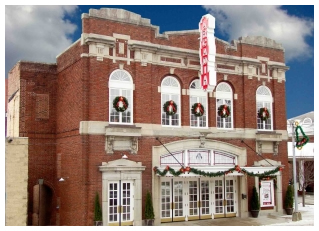
The
Arcadia Theater, which opened on May 5, 1921 was designed by Henry
Reinhold and Ralph L. and architects from Philadelphia. The Windber
Lumber Company, a subsidiary of Berwind-White Coal Mining Company,
built the theater with money donated by a group of stockholders known
as the Windber Theater Corporation. It became one of the most significant
of the various recreation and entertainment opportunities provided
by the company for its mining employees.
The Arcadia Theater showcased many vaudeville acts as well as cinema
productions before being sold in 1963, and renamed "Cinema 56." In
1975 the theater was closed. In 1977, however, the Penn Wood Players
began to make plans to make the Arcadia their headquarters; but the
Johnstown Flood of 1977 severely damaged the building and the theater
was closed.
In 1989 the Eureka Coal Heritage Foundation purchased the theater
in order to restore the once grand Arcadia Theater to its former splendor.
The restoration began in 1990 with the building architects using old
pictures and the memories of many people for the interior and exterior
designs. The intent of the restoration was to make the theater look
as it did in 1921.
On October 31, 1998 the Arcadia re-opened its magnificent doors with
the production of the "Best of Broadway."
With the exception of present day computer technology to control both
sound and light systems, the Arcadia Theater has successfully recaptured
its original beauty and "magic" with both its appearance and live
performances monthly.
The ECHF acquired the Arcadia Theater building at 1418 Graham Avenue
in October, 1989. It had sat empty since being severely damaged
in the 1977 Johnstown flood. It's central location in downtown Windber
and long history of service to the community made it an obvious
choice for it's restoration to be one of the first projects undertaken
under the Allegheny Industrial Heritage Foundation.
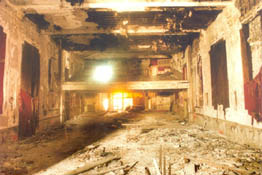
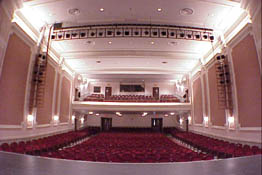
The first order of business was to replace the roof to prevent further
damage to the interior of the building and to provide cover for
all the interior renovation that was needed. Some portions of the
original roof had deteriorated to the point where open sky could
be seen from the interior. The ECHF contracted with Leonard S. Fiore,
Inc. to install a 20-year Firestone rubber membrane roof on the
building for $101,050.
One of the most vexing issues was dealing with asbestos in the building's
plaster. Several different studies had to be done just to ascertain
whether or not the original plaster would have to be replaced. The
decision was complicated by the fact that there were actually three
different layers of plaster, only one of which exceeded the allowable
amount. In the end, all the plaster had to be removed and replaced.
U.S. Asbestos Company of Pittsburgh was awarded a contract for $118,000
for the work.
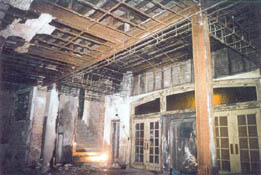
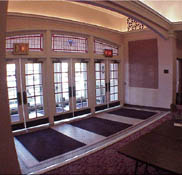
The project was broken down into four phases. Phase I (Historic
Research and Documentation), and Phase II (Schematic Design) were
awarded to the firm of Ritchie and Fiore for $44,000. Phase III
(Design Development) and Phase IV (Construction Documents) were
left open for renegotiation.
The National Park Service, which was overseeing the funds for the
projects, required that the Pennsylvania Heritage Preservation Commission
approve the intended use of the building. In addition to these organizations,
a number of other organization were involved in project planning,
including:
- PA Heritage Affairs Commission
- PA Historical and Museum Commission
- America’s Industrial Heritage Project
- Somerset Historical Center
- Somerset County Heritage Preservation Committee
- Allegheny Ridge Heritage State Park Project
Power was restored to the Arcadia Building in June of 1990.
The Historic Research and Documentation phase of the project began
in July, 1990 with personnel from Kaufmann, Hickey of Lancaster,
PA spending several days on historical documentation of the theater,
gathering samples of ornamental moldings, etc. They determined that
the theater originally opened on May 5, 1921. It's architect, Henry
Reinhold, Jr. also designed Windber's Old Post Office building,
later renamed the Boy Scout Building, and later acquired by the
ECHF to house the Windber Coal Heritage Center.
Among the various documents prepared for the project was a comprehensive
Code Review Report on codes for accessibilitiy, safety, building
and fixtures, submitted in October, 1990. It, along with inputs
from other experts, formed the base from which most renovation work
proceeded. JDA Lighting Consultants and acoustical consultants from
Lewis S. Goodfriend & Associates provided solutions for upgrading
technology in the theater with minimum impact on historical accuracy.
A proposal for Phases 3 & 4 of theater project was received
from Ritchie/Fiore Architects in November, 1991. Theater construction
documents were completed during 1992, and salvaging and asbestos
removal specifications.
In 1994 the ECHF obtained a grant agreement for PA State funds
for theater renovation, with a bank bridge loan to cover construction
while the grant money came in over three years. Windber Borough
provided the vehicle for this action.
In May 1995, Lawrence Lassak was offered the position of contruction
supervisor/inspector for the Arcadia, and Wilson Construction Co.
was selected to do the rehabilitation work. The ECHF objected to
one of the subcontractors selected by Wilson Construction because
of poor performance in another local project, and a replacement
was selected after some legal hassling. Groundbreaking for Arcadia
construction took place on June 5, 1995.
A typical number of design glitches were discovered and resolved.
For example:
- The design included fewer women's bathrooms than men's (solved
by switching them)
- The lighting operators in the projection booth couldn't see the
stage well (redesigned the projection room layout)
- Some interior partitions had to be eliminated to accomodate dressing
rooms for performers.
- The floor grading was too steep under the Americans with Disabilities
Act (required repouring the concrete floor of the entire theater)
On November 29, 1995, the ECHF contracted with Warren Davihizar
for an engineering evaluation of the theater, primarily to test
the load strength of the balcony.
Puricelli & Contantino Architects were hired to complete the
construction effort.
Major investments were made to completely replace the interior
of the theater, including new carpeting, seating, audio and video
technology, moldings and fixtures, stage curtains, etc.
State auditors visited the Arcadia in July 1997, making suggestions
to close out current grant to allow action on other pending grants,
even though work not fully completed.
